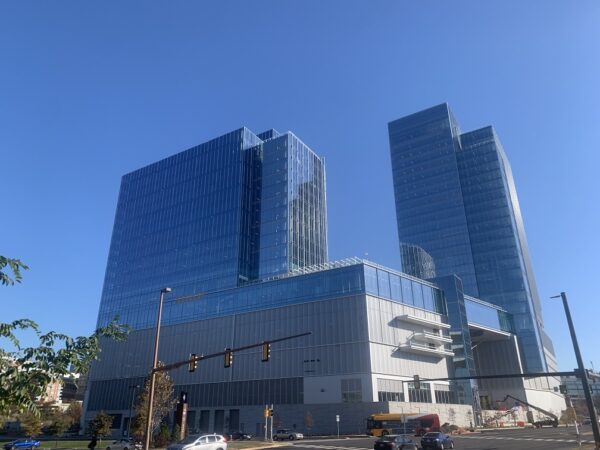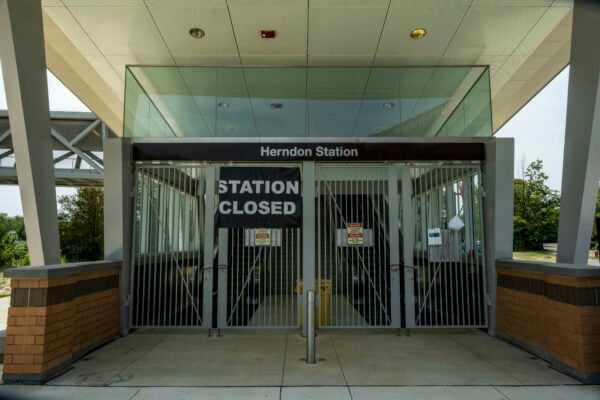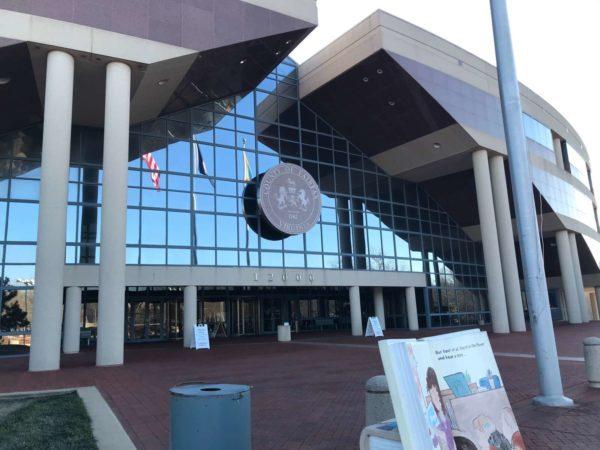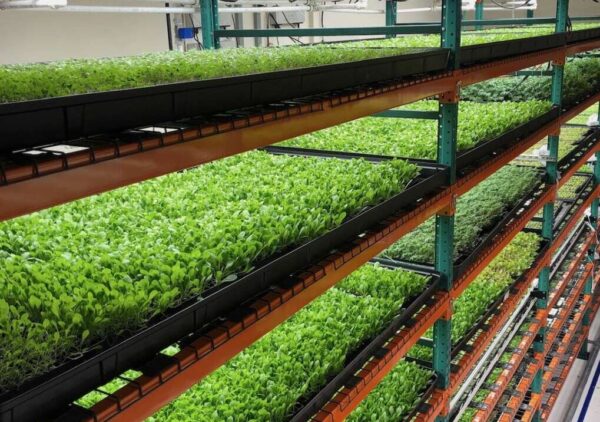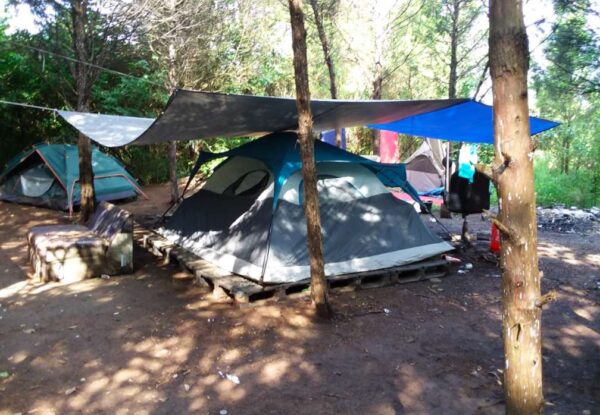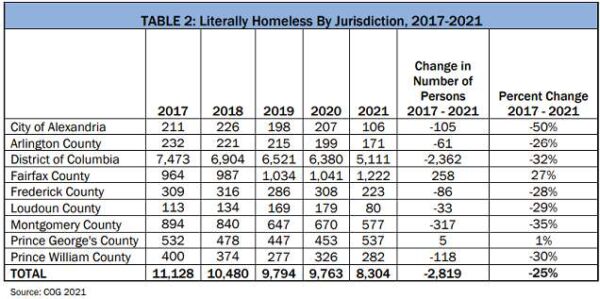County Government to Develop COVID-19 Memorial — “Fairfax County supervisors on Feb. 8 directed staff from the county’s Facilities Management Department, Park Authority and other agencies to begin planning for a COVID-19 memorial that will be placed on property owned by the county government or its park system.” [Sun Gazette]
Reston Association to Host Candidate Forum — Residents can meet candidates running for RA’s Board of Directors election in a debate-style forum on Feb. 23. [RA]
McKay Responds to Senate Move on Mask Authority — Fairfax County Board of Supervisors Chairman Jeff McKay said that he is deeply disappointed in the state Senate’s attempt to overturn local authority to be able to require masks in schools. He says that a “one size fits all directive will only put our children and teachers at risk.” [McKay]
Photo by David Taube
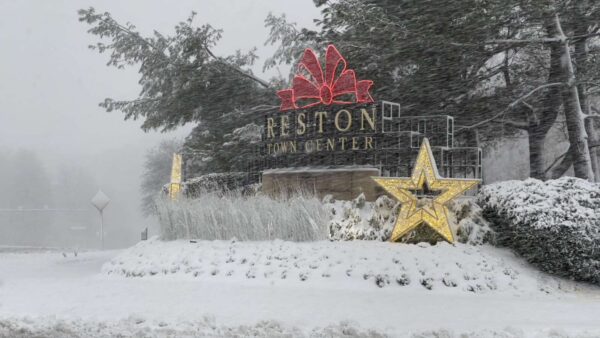
State of Emergency Declared for Snow — “Governor Ralph Northam today declared a state of emergency in advance of a winter storm that is predicted to bring snow and other winter weather to many parts of Virginia. This storm, expected to arrive Thursday evening into Friday morning, comes on the heels of a storm Monday that left more than a foot of snow in some parts of the Commonwealth.” [Office of the Governor]
Reston Company Sponsors NASCAR Driver — The technology contractor Leidos is teaming up with basketball legend Michael Jordan’s racing team to become the official sponsor for Bubba Wallace, the only full-time African American driver in NASCAR. Wallace’s new Leidos No. 23 car will debut at the Circuit of the Americas in Austin, Texas, in March. [WTOP]
Cornerstones Highlighted in ‘State of the County’ Address — Community partnerships have been vital to Fairfax County’s COVID-19 response over the past year, Board of Supervisors Chairman Jeff McKay said earlier this week. The Reston-based nonprofit Cornerstones is among the groups involved, providing primary medical care, dental care, pharmacy assistance, and COVID-19 testing. [Patch]
County Seeks Farmers Market Vendors — Applications for farmers and other producers to serve as vendors at the Fairfax County Park Authority’s farmers markets will be open from Jan. 21 to Feb. 11. The county operates 10 markets, including the Lake Anne Village Center market in Reston and one by the Red Caboose in Old Town Herndon. [FCPA]
As Silver Line Phase 2 slowly pulls into the station of completion, local officials are expressing their frustration at constant delays and missed deadlines.
In a brief update at yesterday’s (Sept. 28) Fairfax County Transportation Committee meeting, it was reiterated that Silver Line Phase 2 is expected to be substantially completed by the end of the year.
“In our discussions with [Metropolitan Washington Airports Authority], they are holding, at the moment, to the fourth quarter of 2021,” said Martha Elena Coello, special projects division chief for the Fairfax County Department of Transportation.
There are currently only two unresolved issues, according to a slideshow presented at the meeting, both of which are at the railyard and do not need to be resolved for substantial completion.
Hunter Mill District Supervisor Walter Alcorn said he was hopeful that meant MWAA would be handing over the project to Washington Metropolitan Area Transit Authority [WMATA] in late October, after the planned outage at Wiehle-East Reston Metro Station to tie-in the two lines. That work was supposed to be completed in June.
If the project does hit this new deadline, it would still be two months from a previous missed Labor Day deadline and years beyond the initial completion date.
Alcorn and others at the meeting showed their frustration at how Silver Line Phase 2 has been besieged by constant delays.
“This is four years overdue from the original date,” said Fairfax County Board of Supervisors Chairman Jeff McKay. “To not express some frustration here… would be a mistake. I think all of us are very frustrated.”
Alcorn also was noticeably exasperated at the pace of the project.
“Our next meeting of the transportation committee is December 14. We better have substantial completion by then,” he said.
In response, MWAA acknowledges the disappointment that many have about the delays.
“We understand the frustrations of everybody, elected officials and public alike,” MWAA spokesperson Marcia McAllister told Reston Now. “Our goal is to proceed with the [October] outage, evaluate the work that is done that weekend, and make decisions as soon as possible.”
McAllister also reiterated that MWAA is “holding on to fourth quarter 2021” as a timeline for substantial completion.
In multiple previous MWAA reports, it was revealed that there were significant disagreements between MWAA and the contractor Capital Rail Constructors (CRC) on the timeline.
While MWAA said it would be completed by the end of the year, CRC said spring 2022.
But now, CRC seems to be backing off their timeline, noting that increased collaboration with the authorities have quickened the pace.
“We are working together with MWAA and WMATA on coordinating and finalizing testing to target substantial completion of the Silver Line Phase 2A in Q4,” CRC project executive Keith Couch wrote in a statement to Reston Now.
Even if Silver Line Phase 2 is substantially completed by late October, as noted in the presentation provided to the committee, WMATA will still need approximately six months to complete testing, pre-revenue preparations, and to open the system to riders.
That could mean an opening date of April or May 2022.
The $2.8 billion public transportation project will include six new stations, extending Metro from Reston to Loudoun County.
It remains a potential game changer for the region, though many with financial investment connected to the project have grown understandably impatient.
“A lot of folks have contributed substianal money to making this happen,” said McKay at the transportation committee meeting. “And they are sitting here, waiting for service.”
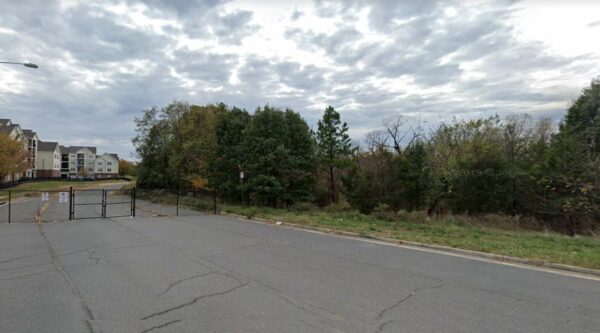
Faced with challenges from providing affordable housing to mitigating flooding, Fairfax County has its hands full, but it’s currently armed with vacant property assessed at tens of millions of dollars.
Currently tax-exempt, the properties could be used for commercial development, environmental preservation, housing projects, recreation, or stormwater drainage, among other purposes.
“There is a critical shortage of affordable housing options in Fairfax County,” Dranesville District Supervisor John Foust said when asked about what the county should do with its vacant properties.
The total financial value of vacant, county-owned properties exceeds $50 million, as calculated based on a public records request and assessments in an online county database for over 100 parcels that could be used for commercial, residential, or other uses.
It wasn’t immediately clear if other restrictions, such as environmental issues, setbacks, and prior plans, limit the use of those properties.
The $50 million-plus figure includes at least $10 million in assessed property that was listed as vacant but nonbuildable, but it excludes properties in floodplains as well as parcels already in use, such as parking lots, parks, or school areas.
One of the largest vacant property acquisitions is across from the Fairfax County Government Center: a 2.6-acre property bordered by Legato Road and Post Forest Drive that cost around $50 million in 1994. It currently has an assessed value of around $11,450.
“One of the elements of the County’s Housing Strategic Plan is to utilize vacant parcels as well as to repurpose land, such as existing parking lots, to increase the supply of housing,” Foust noted by email.
Created in 2018, the Communitywide Housing Strategic Plan calls on Fairfax County to make vacant or underutilized, publicly owned land available for affordable and mixed-income housing “to expand housing options without direct public financial subsidy” through public-private partnerships.
Currently, the Fairfax County Redevelopment and Housing Authority has three such properties that are slated to be developed through public-private partnerships:
- The Oakwood Senior Housing Project, which will provide affordable units for the elderly near Alexandria
- Autumn Willow Senior Housing, a 10.88-acre property near Centreville
- The Route 50/West Ox Affordable Housing Project near Fair Oaks Mall
The county’s more sizable vacant lots include five adjacent properties along South Van Dorn Street in Franconia that occupy around 3.7 acres located near Thomas A. Edison High School.
The county also has a 9.63-acre parcel near the Innovation Center Metro station that will eventually open in Herndon as part of the much-delayed Silver Line extension.
Foust says part of the property includes a community playing field, but its proximity to the Metro station could make it a candidate for future affordable housing.
“Placing affordable housing on the site could be a good use of the land,” he said. “If that came about, the playing field would need to be relocated.”
In McLean, the county has two properties in a residential neighborhood at 7135 and 7139 Old Dominion Drive that have been assessed at a combined $2.06 million. They are slated for a traffic improvement project at the intersection of Old Dominion and Balls Hill Road. The project is currently in the design phase.
Board of Supervisors Chairman Jeff McKay said in a Washington Business Journal story about affordable housing that land is the county’s “single most useful tool.”
“Reallocation of Board-owned property can occur in a number of ways,” McKay said in a statement. “However it is often at the request of a County agency and is followed by an extensive review of the property. Within the last year, the Board was proud to authorize the transfer of two properties to the Fairfax County Redevelopment and Housing Authority for the potential creation of affordable housing.”
Photo via Google Maps

On the heels of last week’s sobering United Nations climate change report, Fairfax County is beginning to implement its first-ever Community-wide Energy and Climate Action Plan (CECAP), which sets goals for reducing greenhouse gas emissions.
Fairfax County staff delivered a final update of the CECAP to the Board of Supervisors during its environmental committee meeting on July 20. The board is expected to accept the report when it meets on Sept. 14.
The CECAP provides an inventory of current greenhouse gas emissions and recommends actions that the county and individuals can take to mitigate future emissions in order to achieve carbon neutrality within three decades.
“A lot of times, people feel like this problem is so big and out of their hands, that they feel like they can’t make a difference,” Fairfax County Office of Environmental and Energy Coordination Senior Community Specialist Maya Dhavale said. “I feel like it’s very timely that Fairfax County has been putting this plan and report together…We’re able to provide residents, business owners, and individuals in Fairfax County a path forward.”
Dhavale, who spearheaded the project, says staff have already begun the process of implementing the plan. That starts with community outreach, public education, and a review of existing county policies to determine how they line up with the proposed plan.
First proposed in 2018 and initiated in early 2020, the CECAP report was developed by a working group composed of environmental advocates, business representatives, civic association members, and other citizens.
As an overarching goal, the work group proposed that Fairfax County become carbon-neutral by 2050 with an 87% reduction in greenhouse gas emissions from 2005 levels.
The Board of Supervisors has already pledged to make county government operations — including building and facility energy use and transportation — carbon neutral by 2040 in conjunction with an updated operational energy strategy adopted on July 13.
The county’s recent push to prioritize environmental initiatives comes as the U.N. continues to sound the alarm on climate change as a crisis that’s already in motion and will only get worse without a substantial shift in human behavior.
In its latest report released on Aug. 9, the Intergovernmental Panel on Climate Change estimates that human activities are directly responsible for a roughly 1 degree Celsius climb in the global surface temperature from 1900 to 2019, contributing to retreating glaciers, rising sea levels, ocean acidification, and increased frequency and intensity of extreme weather events.
Even if future emissions are kept very low, global temperatures will continue going up until at least the mid-21st century and could very likely still be one to 1.8 degrees Celsius higher than 1900 levels by the end of the century, according to the report.
“Stabilizing the climate will require strong, rapid, and sustained reductions in greenhouse gas emissions, and reaching net zero CO2 emissions,” IPCC Working Group I Co-Chair Panmao Zhai said in a news release. “Limiting other greenhouse gases and air pollutants, especially methane, could have benefits both for health and the climate.”
In their report, the CECAP working group says the impact of climate change on Fairfax County is already evident in declining snowfall, more extremely hot days, heavier rainfall, and increased incidences of mosquito and tick-borne illnesses. Read More
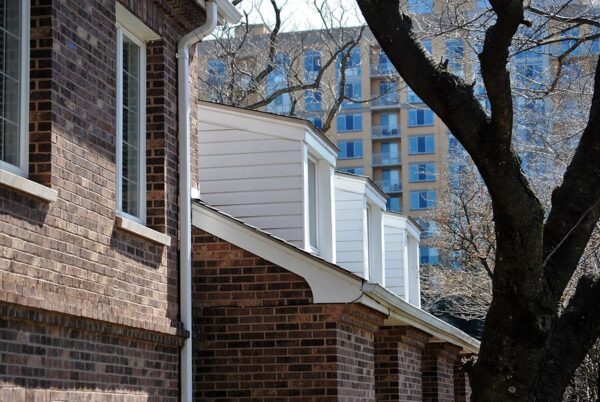
Fairfax County officials support the recent reinstatement of the federal eviction mortarium and plan to continue providing rental assistance to those in need.
Earlier this week, the Centers for Disease Control and Prevention — at the behest of President Biden — renewed the ban on evictions through Oct. 3 in areas that have “substantial” or “high” community transmission of the novel coronavirus.
Fairfax County currently has “substantial” transmission, according to the CDC’s COVID data tracker.
County officials have expressed their support for the eviction mortarium, despite some debate over its legality.
“We are glad that the eviction moratorium has been extended, which will continue to provide peace of mind for families across the country,” Fairfax County Board of Supervisors Jeff McKay wrote in a statement.
Early this year, the county received $34 million for emergency rental assistance from a COVID-19 relief package passed by Congress late last year.
This allowed the county to launch a new Emergency Rental Assistance (ERA) program in early June aimed at helping not only residents, but landlords as well. Since the program launched, McKay says the county has distributed more than $8 million to 997 households through the ERA.
“In Fairfax County, we’re not dragging our feet,” McKay said. “We know our residents need assistance now, and we’re continuing to build upon our existing human services programs to meet the vastly increased need within our community.”
Help is still needed, though. Even with the federal eviction mortarium in place for most of the last 18 months, 668 writs of eviction and 1,562 unlawful detainers have been issued to county residents since July 2020, according to an Eviction Data Dashboard created by county staff.
Overall, the data shows that the threat of eviction is higher in areas hit harder by COVID-19.
According to the dashboard, the zip codes with the highest number of writs of eviction are 22102, which covers west McLean and parts of Tysons, and 22306 in Alexandria, covering the Groveton neighborhood and parts of the Lee District.
Late last year, Fairfax County created an eviction prevention task force to coordinate a countywide approach to helping keep people in their homes.
Fairfax County Neighborhood and Community Services Deputy Director Sarah Allen said in a statement that outreach to the county’s most vulnerable communities is ongoing:
Outreach efforts are underway, particularly to support our most vulnerable communities. Fairfax County agencies partner with numerous providers and are available at community events including vaccine equity clinics, health fairs and back-to-school events to ensure that residents are informed of the assistance and services available to them. We are also partnering with non-profit organizations, houses of worship and other faith-based organizations to reach communities in need.
Allen also notes that tenant and landlord checklists and a guide to the eligibility requirements for rent assistance are available in multiple languages, including Arabic, Amharic, Chinese, Farsi, Korean, Spanish, Urdu, and Vietnamese.
There’s another potentially complicating factor.
The eviction moratorium initially expired on July 31 and was extended on August 3. The CDC order says any eviction completed between August 1 and August 3 is not subjected to the order since it does not operate retroactively, meaning evictions completed during Aug. 1-3 are potentially valid.
However, Allen says the county does not know of any completed evictions during that three-day period.
“We are not aware of any evictions during that gap in time as there is still a court process required to evict,” writes Allen. “County staff is working closely with non-profit legal assistance organizations such as Legal Services of Northern Virginia for support and guidance around the eviction process.”

After a hiatus due to pandemic-related school closures, Fairfax County is not only reviving its School Age Child Care (SACC) program, but expanding it with two new locations, both of them in Herndon.
With Fairfax County Public Schools planning for five days of in-person learning starting Aug. 23, the county-run child care program will be available at 142 schools, including new centers at Clearview and McNair Upper elementary schools, Fairfax County Board of Supervisors Chairman Jeff McKay announced yesterday (Thursday).
“We hope to quell some anxiety today and give our working parents in particular confidence knowing that the Fairfax County government and our Fairfax County Public Schools have worked very closely together over many months to ensure that our kids can return to school and return to our SACC program,” McKay said.
SACC provides before and after-school care for children from kindergarten through sixth grade. Run by the Fairfax County Office for Children, the program operates out of public elementary schools as well as the Key and Kilmer centers, which focus on youth aged 5-21 with multiple disabilities.
As a result, when FCPS initially closed school doors as COVID-19 spread in March 2020, SACC centers were shuttered as well, leaving many families to juggle full-time work and a bumpy introduction to virtual learning on their own.
The county resumed offering some child care services in the summer of 2020 with its Camp Fairfax program, which serves first through seventh graders. The day-long camps were held in school buildings with social distancing and other health measures in place.
When FCPS opted for an all-virtual start to the 2020-2021 school year, the county launched a new Supporting Return to School (SRS) program that essentially functioned like a full-day version of SACC, providing care before and after school hours along with distance learning support.
According to McKay, the Camp Fairfax and SRS sites were chosen based on where the need for child care services was greatest, focusing on children whose parents were unable to stay at home with them or who otherwise lacked structured support during the day.
Just over 1,000 children have enrolled in Camp Fairfax, which returned this summer with smaller sites, Office of Children Director Anne-Marie Twohie said at yesterday’s news conference, which was held at one such site in Centreville’s London Towne Elementary School.
In comparison, the program typically drew over 4,000 children before the pandemic.
McKay says the Camp Fairfax and SRS programs helped the county understand how child care could be provided safely, experience that will be crucial when the full-scale SACC program starts next month.
“The need for high-quality school-age child care has indeed never been greater, and the extended site availability this year will help meet these needs,” said Fairfax County School Board Chair Stella Pekarsky, who represents the Sully District.
Twohie says SACC rooms are generally added in conjunction with elementary school construction and renovation projects.
Work on both McNair Upper (2410 Fox Mill Road) — a new building intended to relieve crowding at McNair Elementary School — and renovations at Clearview (12635 Builders Road) is nearing completion.
With COVID-19 cases on the rise again, McKay and Pekarsky stressed the importance of vaccinations for everyone who is eligible in ensuring that schools and SACC can fully open on Aug. 23 as planned.
“We are continuing to build toward normalcy, full school days, full SACC programs, the freedoms that we’ve enjoyed over the last several months,” McKay said. “We have to, as a community, roll up our sleeves, get to those remaining people who aren’t vaccinated, get them vaccinated so we can continue down the right path in Fairfax County.”
While FCPS isn’t requiring vaccinations for students or staff, the school system said earlier this week that everyone must wear face masks when students are inside school buildings, regardless of their vaccination status.
Noting that at least 90% of teachers and staff are vaccinated, Pekarsky suggested that FCPS could follow the county government’s lead in potentially instituting a vaccine mandate for its employees at some point.
“We are continuing to offer our teachers the opportunity to get vaccinated,” she said. “We will collaborate with county government to explore if we will make them mandatory sometime in the future, but right now, they are not.”

(Updated at 4 p.m.) Virginia recommends that even vaccinated individuals wear masks indoors in certain circumstances, but with different locations experiencing different levels of COVID-19 transmission, the state has stopped short of issuing a mandate.
While some states revised their mask rules shortly after the Centers for Disease Control and Prevention’s announcement on Tuesday (July 27), Virginia had not indicated how it will approach mask-wearing amid rising COVID-19 case levels, with officials saying only that they were reviewing the new guidance.
Gov. Ralph Northam issued the first official statement on the issue via social media on Thursday (July 29), writing that “all Virginians should consider wearing a mask in public indoor settings where there is increased risk of COVD-19 transmission, as the new CDC guidance recommends.”
“This is not a requirement, but a recommendation,” he said.
All Virginians should consider wearing a mask in public indoor settings where there is increased risk of #COVID19 transmission, as the new @CDCgov guidance recommends.
This is not a requirement, but a recommendation.
— Governor Ralph Northam (@GovernorVA) July 29, 2021
These situations include masking indoors at K-12 schools and in areas of the Commonwealth that have “substantial” community transmission of the virus.
Northam noted in further tweets that there has been a dramatic rise in COVID cases in Virginia over the last month due to the delta variant and that “over 98%” of hospitalizations and deaths are residents who are unvaccinated.
When asked why the state is recommending but not requiring indoor mask-wearing, a Virginia Department of Health spokesperson told Reston Now the department “doesn’t have anything to add at this moment” beyond Northam’s statement.
When explaining the decision to revise its guidelines, the CDC cited new scientific evidence showing that vaccinated people infected with the delta variant could potentially spread the virus to others. While the available vaccines effectively protect against severe illness and hospitalizations, the findings concerned officials enough to prompt a reversal of sorts after mask requirements were eased in May.
“This new science is worrisome and unfortunately warrants an update to our recommendations,” CDC director Rochelle Walensky said.
With case numbers climbing locally, as they have elsewhere around the country, Fairfax County has moved to put new rules in place in the hopes of slowing the virus’ spread without jeopardizing plans to reopen workplaces and schools.
Fairfax County Public Schools announced yesterday (Wednesday) that it will require universal masking in school buildings regardless of an individual’s vaccination status, and the Board of Supervisors approved a motion on Tuesday (July 27) to evaluate whether to implement a vaccine mandate for 12,000 county employees.
Board of Supervisors Chairman Jeff McKay said in a statement that he supports a shift back to wearing masks indoors for places with high COVID-19 transmission and around people who are unable to get vaccinated:
With the delta variant surging in unvaccinated communities, I support masking in areas with more people vulnerable to contracting COVID-19 who aren’t able to be vaccinated (such as schools) and areas with a high risk of transmission. In Fairfax County we will continue to follow state guidelines on masking and sharing the effectiveness of masking to slow the spread of COVID-19.
Currently, 76% of Fairfax Health District residents over the age of 18 have received at least one dose of the vaccine and 69.4% are fully vaccinated, according to the Fairfax County Health Department’s vaccine dashboard.
While that’s above Virginia and national rates, those numbers have barely budged over the last several weeks as the county looks for ways to get more residents immunized.
Health experts and public officials continue to reiterate that vaccines are the best tools in the fight against the pandemic.
“The vaccine is the strongest tool we have to fight this pandemic,” McKay wrote. “For the sake of our economic recovery, sending students back to school, and returning to normal, we need even more people to get vaccinated. If you aren’t vaccinated, go to vaccine.gov to get scheduled, there are appointments available near you!”
In terms of transmission rates, Fairfax County is currently doing better than many other Virginia counties. But in all areas, case rates are ticking up.
While the CDC’s COVID tracker shows that a large swath of the Commonwealth has “substantial community transmission,” Fairfax County currently has “moderate” transmission like Arlington County. A number of nearby localities like the City of Alexandria, Stafford, and Spotsylvania counties have “substantial” or even “high” transmission.
D.C., which has substantial spread, announced today that it will require everyone 2 and older to wear masks indoors regardless of their vaccination status starting Saturday (July 31).
(Updated at 11:30 a.m.) Fairfax County could require all of its employees to get vaccinated against COVID-19 when they return to offices this fall.
During their meeting today (Tuesday), the Fairfax County Board of Supervisors unanimously approved a motion brought by Chairman Jeff McKay directing County Executive Bryan Hill to evaluate whether to implement a vaccine mandate for the county’s 12,000 government employees, who range from library staff to police and solid waste workers.
While the county has reported relatively high vaccination rates, with almost 80% of adults having gotten at least one dose, some people who are eligible for the vaccine are choosing not to get it because of “false information,” according to McKay.
“Getting vaccinated is an act of public charity,” McKay said. “It’s not just about protecting you, but protecting everyone that you work with, every county resident that seeks our services, and everyone that works in our community.”
McKay confirmed that Hill is currently developing a plan for county government employees to return to offices in September.
The board directed Hill to consider providing some exemptions from the vaccine mandate for “religious and medical purposes” as well as requiring face masks and weekly COVID-19 testing for employees who do not qualify for an exemption and continue to refuse to get vaccinated.
In introducing the motion, McKay cited the growing prevalence of the delta variant, which now makes up more than 80% of all new cases in the U.S. and an estimated 69.4% of cases in the mid-Atlantic region, including Virginia, according to the Centers for Disease Control and Prevention.
Like elsewhere in the country, Fairfax County has seen a rise in cases throughout July.
McKay noted that the need to bring COVID-19 case levels back down is especially urgent as Fairfax County Public Schools hopes to reintroduce five days of in-person learning when the new school year starts in August.
“What is happening right now with the delta variant in our community is scary for so many people, and I know it’s scary for our public school system,” McKay said. “Keep in mind that there are thousands of kids in elementary school that don’t have the luxury of getting vaccinated, and we need to do it for them. We need to make sure that our schools can reopen fully and safely, and we all need to get vaccinated to ensure that that happens.”
The board’s move comes as the CDC is expected to announce this afternoon a reversal of its policy allowing unvaccinated people to go maskless indoors, as reported by The Washington Post and other national outlets.
David Taube contributed to this report.

America won’t celebrate its 250th birthday until 2026, but Fairfax County has decided it’s not too early to start planning the party.
At the Fairfax County Board of Supervisors meeting on Tuesday (July 13), Gunston Hall Executive Director Scott Stroh presented a report on behalf of a seven-person work group with recommendations for how the county could observe the U.S.’s semiquincentennial anniversary.
Recommendations touched on thematic, organizational, and practical considerations, among them adopting the word “commemoration” to describe the anniversary, making sure it reflects the “fullest American story,” and issuing a countywide survey of residents about what they want out of the occasion.
Additionally, the work group recommends having an organizational structure, a marketing and promotional plan, and a preliminary multi-year budget set by the end of the year.
“This commemoration offers an important and compelling opportunity to celebrate our accomplishments and progress as a nation and community, but also opportunities to foster cooperation, facilitate conversation, and inspire actions so that all can equally enjoy the benefits of life, liberty, and the pursuit of happiness,” Stroh said. “Fairfax County is distinctly positioned to lead this effort in Virginia.”
July 4, 2026 will represent 250 years of American independence from Britain, which is generally marked from the full adoption of the Declaration of Independence and formal start of the Revolutionary War. Both nationally and in Virginia, committees, organizations, and work groups are taking shape to start preparations for the anniversary.
Fairfax County is the only municipality in the Commonwealth to have initiated this effort to date, according to materials provided to the board.
“I’m glad we are leading by example,” Board of Supervisors Chairman Jeff McKay said.
The board established Fairfax County’s work group in October 2020. It includes representatives from Visit Fairfax, George Washington’s Mount Vernon, the Fairfax County History Commission, and the City of Fairfax Regional Library.
Going forward, the work group suggested that it could become a “more formal planning entity,” one with a larger membership that’s more diverse and more representative of the county as a whole.
Stroh anticipates the planning and the commemoration itself will be paid for through a variety of methods, including county funds, grants, state money, and private support.
In general, the board seemed pleased with the report, but it didn’t take any action beyond accepting the report. Instead, a board matter outlining possible next steps will be proposed when the board next meets on July 27, McKay said.
McKay emphasized that the commemoration should be inclusive and tell a “fuller American story.”
“I think many of us have heard of this notion of erasing history or redoing history,” McKay said. “In fact, [it is] quite the opposite. We are trying to bring to light the entire history and how we do better in the future.”
Lee District Supervisor Rodney Lusk made similar comments, saying his daughter recently remarked on many of America’s founders being slaveholders.
“That is a contradiction. That is a flaw,” he said, while reading off a portion of the report that positions commemoration as a chance to assess how the country is still striving to match its ideals with its actions.
“[This commemoration] is more than a chance, it’s an opportunity to actually do this,” Lusk said.
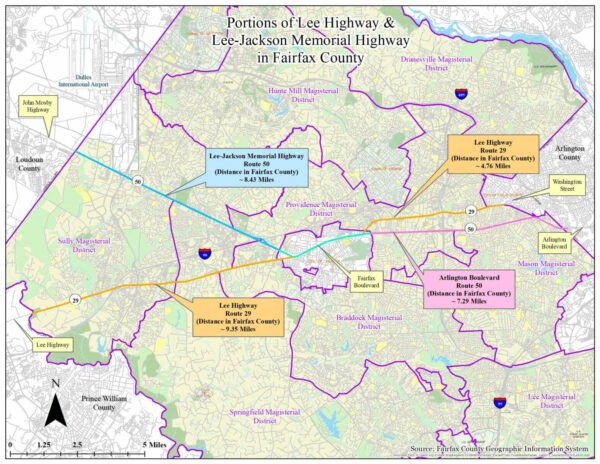
(Updated at 9:20 a.m. on 7/15/2021) Fairfax County is convening a “Confederate Names Task Force” specifically charged with making a recommendation about renaming the county’s portions of Lee Highway and Lee-Jackson Memorial Highway.
The Board of Supervisors approved the appointment of the 30-member task force on Tuesday (July 13).
The task force’s mission is to review the names of Lee Highway (Route 29) and Lee-Jackson Memorial Highway (Route 50) to determine if the roads should be renamed and, if so, what the names should be. A county-appointed facilitator will also work with the task force.
The roadways currently bear the monikers of Confederate generals Robert E. Lee and Thomas “Stonewall” Jackson.
This is a direct result of the work done by the county’s history commission to identify and inventory every place in the county named after a Confederate. The 539-page report noted that there were about 157 streets, parks, monuments, subdivisions, and public places in the county bearing names with ties to the Confederacy.
The most prominent were Lee Highway, about 14 miles of which runs through the county around Merrifield, Fairfax, and Centreville, and Lee-Jackson Memorial Highway. About 8.5 miles of that roadway runs through the county, including Chantilly and near Fair Oaks Mall.
“In Fairfax County, our diversity is our greatest strength and it’s important that we honor and celebrate that diversity,” Board of Supervisors Chairman Jeff McKay said in the press release. “We cannot ignore what the Lee and Lee Jackson Memorial Highway names represent in our community and especially to our African American neighbors. The Confederate Names Task Force, which includes a diverse group, will examine and make recommendations on how both roadways can better reflect our values as we chart a positive path together for the future.”
The task force will meet monthly, starting later this month or early August, according to the agenda for the board meeting. The meetings will be open to the public, and the task force will seek input from the public prior to making a decision.
The group is expected to provide a recommendation to the county board by “the end of calendar year 2021.”
The task force is chaired by Sully District Planning Commissioner Evelyn Spain, who will be joined by 29 other members, including historians, civic organization leaders, homeowners’ association members, residents, professors, and faith leaders.
Spain says reevaluating the use of Confederate street and place names is necessary if Fairfax County wants to be inclusive and respectful of its increasingly diverse population.
“Naming highways after Robert E. Lee and Stonewall Jackson celebrates men who fought a war against the United States to perpetuate slavery,” Spain said in a statement. “One Fairfax requires us to look at these issues through an equity lens to understand how these names have negatively impacted our community and people of color as well as how Confederate names adversely impacts them today…I’m honored to be a part of the Confederate Names Task Force as we work toward building a more inclusive and equitable Fairfax County.”
If the task force recommends changing the names of the roads, the county will have to undergo a somewhat complicated process to actually make it happen — much like it was when Arlington renamed its portion of Route 29 and Alexandria renamed Route 1, which had been named after Confederate President Jefferson Davis.
If changes are recommended, the task force would need to provide two to five alternate names for each road. Then, the county board and task force will hold at least one public hearing to allow for comment about the potential change.
After the public hearings, the board will then vote on whether to take the task force’s recommendation. A timeline laid out back in May projected that could happen in early 2022.
If the board votes to change the highway names, it would then submit a resolution to the Commonwealth Transportation Board requesting the changes while also committing to paying for the signage.
If that’s approved by the Commonwealth, the board has to pass a budget item for the cost of the signs, and an interdepartmental working group would set up a timeline for the actual switching out of signs and, finally, officially changing the roads’ names.
The working group will also coordinate with other jurisdictions on their name changes.
via Fairfax County
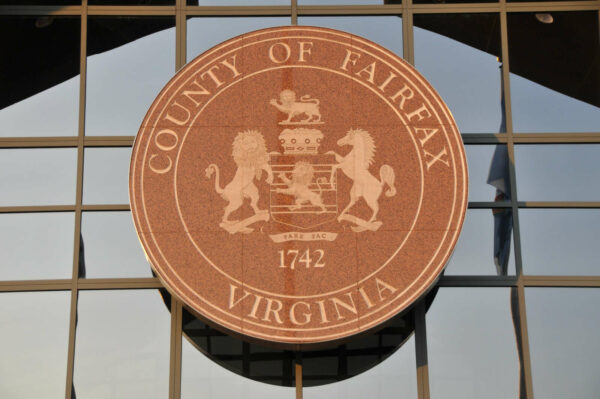
Fairfax County will conduct a “comprehensive review” of the county’s response to the COVID-19 pandemic.
At today’s (July 13) Board of Supervisors meeting, Chairman Jeff McKay proposed as a board matter to have County Executive Bryan Hill review how county agencies responded to the challenges of the pandemic, how operations were affected, and how operational changes impacted the community.
The review will take place in two parts. The board directed staff to deliver a report with conclusions, recommendations, and areas of improvement in February 2022, and a follow-up is anticipated since the pandemic is still ongoing.
The motion passed unanimously.
“We did an amazing job [dealing with the pandemic],” McKay said, but he acknowledged that a review is needed since “there’s much to be learned about the county’s response and how we can improve upon that for the future.”
McKay also noted that a review is already essentially under way, but this formalizes the process and sets a deadline on it.
Hunter Mill District Supervisor Walter Alcorn agreed with the effort and asked the county executive not to pull any punches.
“I ask the county executive not to shy away from identifying challenges…[particularly] those in the labor market that were attributed to the pandemic and what happened after,” Alcorn said.
As noted in McKay’s comments, more than 75% of Fairfax Health District residents 18 years or older have received at least one vaccine shot. That’s above both national and state averages.
However, the county continues to face some challenges in convincing those who are still hesitant to get vaccinated.
When it comes to addressing COVID-19’s economic impact, the county has provided assistance with rent, food, and other basic needs to more than 10,000 households and helped get permanent housing for 400 individuals who were experiencing homelessness when the pandemic began, according to McKay’s board matter.
The county has also distributed more than $52 million in small business relief funding through the RISE program and is offering $25 million in their PIVOT program.
While half of the RISE grants went to minority-owned businesses, those particular businesses still suffered “acutely” during the pandemic. What’s more, the Northern Virginia Black Chamber of Commerce recently called out the county for their belief that they were neglected in the development of some of the grant programs.
McKay said that getting a comprehensive report on Fairfax County’s COVID-19 response will help the county government “ensure we maintain the level of service and functionality our community expects” in any future large-scale crisis or emergency.
via Machvee/Flickr

(Updated, 12:20 p.m.) The Fairfax County Government Center, where county policy is created and official functions take place, is an imposing, modern-looking building. Above the main doors is the county seal: a royal-looking crest with lions, a horse, and the date “1742.”
Unlike the building, the seal is of a different time. Adopted seven decades ago, it bears a version of the coat of arms belonging to Thomas Fairfax, the sixth Lord Fairfax and a slaveholding British loyalist who once owned much of the land that makes up Fairfax County today.
As neighboring counties and cities reexamine their logos and symbols, it seems like only a matter of time before Fairfax County faces its own questions.
When asked if there’s been discussion about further research into the county logo, representatives of the Fairfax County History Commission said it’s not on the agenda or a priority right now.
The commission is currently undertaking an inventory of local African American history after completing one about Confederate names on public places.
Fairfax County Board of Supervisors Chairman Jeff McKay wrote in a statement to Reston Now that officials are listening to the community but have yet to hear about any issues with the county seal.
America was unfortunately built in part through the oppression of people of color. We cannot separate this history from Fairfax County, but we can listen to the community on what symbols are continuing to create divisiveness and inequity. Symbols of the Confederacy, for example, do not speak to the County’s values today, so we are working to remove these through the proper processes. Currently, there are ongoing efforts to change road names as well as other Confederate symbols and the Board previously took action to remove the monument of John Quincy Marr from the courthouse. We have not heard from our community members that these same messages are felt from the County seal. We continue to invest significant resources into our historically underserved communities to ensure that everyone has the opportunity to thrive in Fairfax County.
The county selected the seal as its logo in 1949 ahead of an impending visit from the then-Lord Fairfax. It won over a dozen other seals belonging to the Fairfax family due to “its clarity when reproduced,” according to historical documents from Fairfax County Public Library’s Virginia Room.
A county flag with the seal was unveiled on June 13, 1968, the day before Flag Day, in response to repeated requests for a flag from county schools.
“We probably ought to have a Betsy Ross here to get the flag ready for Flag Day,” said Gil Shaw, the flag’s creator and the county’s director of information services at the time. “But the coat of arms of Thomas Lord Fairfax will soon fly over the lands he once owned and which became Fairfax County in 1742.”
Early colonial Virginia land history is admittingly a bit confusing due to the limited availability of written records and a lack of variety in names.
“The famous one, for our purposes, was the sixth Lord Fairfax,” explains Steve Harris-Scott, an assistant professor in George Mason University’s history department and an expert on colonial Virginia history.
“The nobles generally passed on their names to their first-born son, so when they took over the title, they were all the same names,” he said. “There was a Thomas Fairfax, first Lord Fairfax, then there was Thomas Fairfax, the second Lord Fairfax, etcetera.”
The sixth Lord Fairfax was born in England in 1693 to the fifth Lord Fairfax and Catherine Culpepper.
Through his mother’s side, he inherited about 5 million acres of land in 1710 known as the “Northern Neck,” which encompassed today’s Fairfax County. Taken from the indigenous people who had lived there for centuries, the land was a gift to Catherine’s father, Thomas Culpepper, from the restored King Charles II for his support during the English Civil War.
“[This land] is essentially bordered by the Rappahannock [River] on the south and the Potomac on the north,” Harris-Scott said.
However, Fairfax spent most of his life in England and didn’t move to Virginia until 1742, the date on the county’s logo. He also may never have resided in what is now Fairfax County, according to Harris-Scott. Read More
(Updated at 2:10 p.m. on 5/27/2021) Beanstalk, an indoor vertical farming start-up, is putting down roots in Herndon with plans to invest more than $2 million to open a facility and farm this fall.
The Virginia-based company is expanding and opening a “scaled-up version” of their existing farm in the Lorton/Springfield area right off of Herndon Parkway and near the impending Herndon Metro station, Beanstalk co-founder Michael Ross writes Reston Now in an email.
The Herndon location will have research, growing, and package operations.
“This new facility will produce the equivalent of over 50 acres of traditional farmland and allow us to expand into more local grocery stores, farmers’ markets, and restaurants,” said Ross, who founded Beanstalk with his brother Jack.
The company grows pesticide-free leafy greens and herbs year-round using robotics and hydroponic — or soil-less — growing technology. It says it saves space by growing in layers and vertically as opposed to horizontally.
Beanstalk sells its salad mixes and herbs at grocery stores, local farmers markets, and online.
Jack Ross was selected by Virginia for a STEAM catalyst award back in 2018 for his development of an automated indoor growing production system. The technology allows Beanstalk to “produce food four times as efficiently as traditional hydroponic farming,” according to a press release from Virginia Gov. Ralph Northam.
The brothers opened their 3,000 square-foot Springfield/Lorton facility in 2018, and the company expects to have annual sales of over $5 million in the next three years.
“We have created a new technology that produces better tasting and more nutritious vegetables, herbs, and fruits than what are available today,” Ross said. “Our farms are also sustainable as they consume 95% less water, have zero chemical run-off, and are over 100 times more productive use of land.”
The company’s co-founders are in their 20s and both were raised in Alexandria, went to high school in D.C., and played youth sports across the region.
“I particularly spent a lot of time in Herndon and Reston in high school, which is how I originally got to know the area through events like the Herndon Festival,” said Ross, who studied aerospace engineering in college.
He tells Reston Now that they evaluated “dozens of cities” in the D.C. area for their expansion but decided on Herndon because of the town’s “incredible community” and prioritzation of sustainability.
“Herndon is a very unique place within Northern Virginia in that it feels like a small, close-knit town with all the benefits of a larger city,” he said.
Beanstalk is expected to create 29 jobs in Herndon, some of which are already open for hiring.
Positions currently open in Herndon include a director of research and a senior electrical engineer. Ross notes that other jobs will be available soon in engineering, research, and operations, and the company will be looking for farmers later this year.
“We look for people from all backgrounds who want to bring locally grown food to their community and are curious, ambitious, and skilled,” Ross said.
Beanstalk is receiving financial support from both the state and Fairfax County in the form of grants that total $200,000.
As expected, local leaders say they are thrilled that Beanstalk decided Herndon is the place for them to grow.
“We are always looking for innovative investments to move our economy forward in Fairfax County,” Fairfax County Board of Supervisors Chairman Jeffrey McKay said in the governor’s press release. “Beanstalk’s new facility will not only bring new jobs to the community, but it also is a creative solution to using advancements in technology to increase access to fresh food options.”
Herndon Mayor Sheila Olem also welcomed the Ross brothers and Beanstalk to town.
“Theirs is exactly the kind of innovative, jobs-producing business we are looking to attract to our town’s commercial sector, and we applaud their application of technology toward provision of healthy, locally-grown produce,” she said.
Beanstalk’s mission is not only to grow fresh produce using new, more-efficient, sustainable technology, but to provide food at its freshest, Ross says.
“By growing in a farm within the community, we deliver food at peak freshness, which ensures all the taste and nutrition of the food is there when you take your first bite,” he said.
Photo courtesy Michael Ross
A new report by the Metropolitan Washington Council of Governments (COG) highlights some remarkable regional success in reducing homelessness. In Fairfax County, the numbers seemed to tell a different story, but county leadership says some of that is a result of the way the survey is conducted.
The annual study sends researchers across regional localities to collect a snapshot of how many residents are experiencing homelessness, and while not a comprehensive scientific count, it’s generally seen as a look at regional trends.
While neighbors like Arlington County and the City of Alexandria reported declines in their homeless population counts by 14% and 49%, respectively, Fairfax County is one of only two out of nine jurisdictions surveyed that saw its homeless count increase.
In Fairfax County, homeless population counts went from 1,041 in 2020 to 1,222 in 2021, a 17% increase. The only other D.C.-area locality to report a year-to-year rise in its homeless population was Prince George’s County, which increased by 19%.
Fairfax County claims on its website that the increase reflects an expansion of shelter capacity and services, rather than an increase in homelessness.
“The increase is primarily attributable to the increase in the community’s capacity to provide shelter with increased federal emergency funding associated with the COVID-19 pandemic, and the commendable efforts of service providers to care for unstably housed community members,” the Fairfax County Office to Prevent and End Homelessness said.
Fairfax County Board of Supervisors Chairman Jeff McKay similarly credited the increase in the count to an increase in accommodations for people experiencing homelessness.
“This year’s data indicates an outstanding effort by our Housing staff and our community-based partners to respond to the unprecedented impacts of 2020,” he said in a statement. “By providing safe housing accommodations and a wide variety of supportive services to assist our most vulnerable neighbors along the path toward housing stability, we have been able to help our entire community.”
However, since at least 2017, the homeless population counts for Fairfax County have been gradually increasing, which McKay says is also indicative of an inadequate affordable housing stock.
Released in two parts across 2018 and 2019, the county’s Communitywide Housing Strategic Plan set a goal of producing a minimum of 5,000 net new affordable housing units within 15 years. 1,800 units are currently in the pipeline, according to McKay.
In his statement on the homelessness point-in-time count data, McKay said:
Most importantly, it indicates that our work on the issue of housing — including emergency housing — must and will continue to be a critical priority for this Board. This is an essential component of our community’s crisis response system for those who need help in regaining a safe, decent and stable housing situation.
Housing is a foundational component in achieving positive outcomes in nearly every aspect of our lives and having thousands of our neighbors experiencing homelessness or struggling to remain in their homes is not something that we as a community will turn a blind eye to. This could be any of us. There are too many circumstances beyond our control which can cause that stability to be shaken through no fault of our own.
Photo via MWCOG


